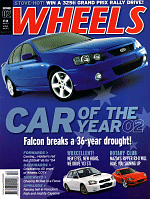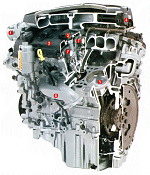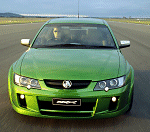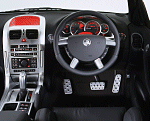
Extracts from WHEELS Magazine - December 2002 - pages 14-15,19,40-45
|
HFV6: LION-HEARTED Here's why Holden's high-tech six will roar in '04 1 - ELECTRONIC THROTTLE VALVE - With HFV6, commodore will move to a fly-by-wire, computer-controlled throttle valve, like Falcon, This 3.6-litre version of the engine uses a 68mm throttle. Holden will probably specify a larger bore if it goes for 200kW 2 - CAMSHAFT COVERS - Made from injection compression thermoset composite, otherwise known as high-tech plastic, and vibration isolated for quietness 3 - COIL-ON-PLUG IGNITION - Each cylinder's single spark plug is topped with its very own coil. HFV6 also features individual cylinder knock control 4 - VARIABLE INTAKE MANIFOLD - This electrically operated flap changes the effective length of the resonance-tuned intake manifold. Equal-length runners help cut noise, says GM 5 - ALUMINIUM PISTONS - HFV6 pistons feature low-friction polymer-coated skirts and fully floating gudgeon pins. This Canadian-made 3.6-litre example has a 94.0mm bore, 85.6mm stroke and 10.2:1 compression. At least one of these figures must change in Holden's 3.8-litre version of the all-aluminium engine 6 - EXHAUST MANIFOLD - There isn't much of it in the HFV6, but the exhaust manifolds are made from cast iron 7 - DOUBLE OVERHEAD CAMSHAFTS - Four cams, four valves per cylinder. Check the neat roller-finger followers and conically wound valve springs. What you can't see here are the four continuously variable cam phasers, a first for GM. Cam drive is by chains. Three of 'em... HOLDEN'S FURIOUS V6 As reported, the HFV6 will first appear in the updated Cadillac CTS rear-drive sedan, scheduled to go on sale late next year. The vital statistics of the Caddy's Canadian-made 3.6-litre engine make it clear that the larger Australian-made version of the all-aluminium motor for the late-2004 Commodore will be bloody strong. Even if it doesn't quite manage the double century, the Holden 3.8-litre HFV6 will certainly out-power Ford's current 4.0-litre in-line six. GM's 'preliminary output' claim for the 3.6-litre HFV6 from St Catherines, Ontario, is 190kW, or 8kW more than the Falcon's Barra 182kW six. The specific output of the Canadian engine is 53kW per litre. Use this figure to calculate the output of a 3.8-litre HFV6, which is what Holden will build at Fishermans Bend, Victoria, and the result is 201kW. Whether they can deliver this much power depends on a number of factors. First, and perhaps most important, is compression ratio. The equation is simple: more compression equal more power and efficiency, but it can dictate the use of high-octane fuel to avoid destructive knocking when load and revs are high. The Cadillac 3,6 HFV6 runs 10.2:1, with premium 95 RON (Research Octane Number) unleaded recommended. "All Holden's mainstream engines are calibrated for 91 RON fuel," say Holden's gruff engineering chief, Tony Hyde, in answer to the question of what grade of unleaded the Commodore HFV6 will burn. His statement does not completely rule out the possibility of Holden using compression above 10.0:1 in its new V6. There are a number of engines already sold in Australia that happily burn 91 octane in very squeezy combustion chambers. Honda's 1.3-litre four-cylinder for the new Jazz, with a ratio of 10.8:1, is just one. Hyde declines to reveal the compression ration Holden has chosen for its Commodore engine, or any other details that might point to its power output. For instance, will the Holden 3.8 rev to the smae 6700rpm cut-out as the Cadillac 3.6? Hyde isn't telling. He offers only one further clue as to the potential of the new Commodore engine: "I will say that there are not many different versions of the engine." Sounds very much like a hint from the poker-faced engineer that Holden's HFV6 will share most of the high-tech features of the Cadillac engine, doesn't it? If the Commodore HFV6 is similarly equiped, Holden may be able to deliver a 200kW engine that runs on 91 octane. Comvine a powerful 32-bit Bosch Motronic engine-management computer with electronic throttle control, 50 degrees of adjustment available on allf our camshafts, individual cylinder knock control and coil-on-plug ignition, and you're looking at technologies capable of reconciling high compression with regular unleaded. The all-aluminium HFV6's smooth 60-degree vee angle, six-bolt main bearings, tough forged-steel crank shaft, aluminium pistons (with polymer-coated skirts), four-valve heads and dual-path resonant intake manifold mean that the revs won't be a problem. Ad revs are the reason the 3.8-litre Holden HFV6 will deliver more power than the recently rejuvenated 4.0-litre Ford in-line engine. Where the Falcon six peaks at 5000rpm, the 6500rpm peak power point of the Cadillac 3.6-litre HFV6 points to Holden having an additional 1500rpm to play with. This is more than enough to overcome the small capacity disadvantage relative to the Ford. - JOHN CAREY Fishermans Plant Buds Installation of lines of machine tools and other equipment has now begun. So has hiring, although serious recruitment will not start until early next year. According to Canberra-based consultants Access Economics, the net benefit of the Fishermans Bend HFV6 factory will be 8000 new jobs within four years. In his speech at the construction-completion ceremony, Holden boss Peter Hanenberger confirmed that the HFV6 will be built in four displacements from 2.8 to 3.8 litres. As we've reported before, the other capacities will be 3.2 and 3.6 litres. "These engines have outstanding fuel economy, lower emissions, and sufficient versatility to be tailored to legislated requirements in various markets," he said. Initial production from the Fishermans Bend factory will be exported to Europe. This means that our first chance to sample the Australian-made engine will probably be in an imported, Holden-badged Opel, a Saab, or and Alfa. Cargo Culture It got our attention, alright. It stole the show. And now we want some answers about where the SSX is headed and what it tells us about Holden's upcoming all-wheel-drive collection. According to Holden's product mastermind, Ian McCleave, the company will now undertake some intensive market research, crunch the numbers, and make a decision on the hatch before next May. It could be on the street within 22 months, however timing will depend on its final configuration, and at what point the Elizabeth car plant can handle the increased volume. "I think there is a great opportunity for it," says McCleave. "Any portfolio derivatives that have that same sort of growth potential (as an all-wheel-drive wagon and ute), I think we'll agree to do." The 7000-plus annual production run mooted for local consumption, and the thousand or so more for overseas, should be enough to give the hatchback legs. But, having said that, there are stoushes looming at Fishermans Bend over just how the hatch will evolve. The strongest threat to the SSX's survival is Holden's plan to introduce a smaller car - a Torana, no less - to sit below the Commodore later this decade. McCleave, who confirms this scenario is under consideration, also insists the concept car could morph into something else. "It could evolve into a different sort of hatchback," he says, "a cross between a wagon and a hatch." Such a crossover would have to wait until the more flexible Sigma platform, and the manufacturing facilities around it, comes online with the 2006 VE Commodore. And it gets to the nub of the problem facing both Holden and Ford at the moment: how to modernise their large cars to meet changing customer needs without disenfranchising those who value traditional forms. Of particular concern is the station wagon - still much loved in power-wielding fleet circles, but blocking progress to vehicles offering greater storage and seating options. "We have to be very careful that we balance the requirements of our traditional users of the wagons together with the evolving needs of people who are looking for more flexible solutions," says McCleave. To do this, Holden will turn its current funeral cart into a more European-looking sports wagon, keeping fleets on side with familiar designs and low prices, while at the same time serving up more practical chariots at the higher end. We'll see the first move towards this with the taller, more flexible all-terrain wagon due with the VY Series II update next October. Of course, all-wheel-drive takes root here as well, followed soon thereafter by the Cross 8 ute and the SS Commodore sedan and hatch (SSX). McCleave maintains drivetrain issues are still to be resolved for the all-wheel-drive stable, though our information suggests the choice will be limited to 5.7-litre V8 autos until 2004's VZ update, where both manual and auto variants mated to the new HFV6 engine will be added. A V8 manual and diesel engine are also well into development, the former slated for release before the Gen IV V8 arrives with the VZII/VE. "If you asked me three years ago whether I thought there was an opportunity for a manual transmission all-wheel-drive [V8], I would've said that the volume was too small," says McCleave. "Now ... there'd be a good chance." It will be a comprehensive line-up once VE Commodore comes around, with the all-wheel-drive cars and utes adding 30,000 units to Holden's annual sales. More than 20 percent of these will be shipped overseas to markets including non-traditional destinations like England, Europe, Japan, China and South-East Asia. "It's a heaven-sent opportunity," says McCleave. "It's and area where other people aren't specialising, certainly within GM, so while there's any number of people specialising in front-wheel-drive with all-wheel-drive versions, nobody else is really pushing rear-wheel-drive with all-wheel-drive ... particularly in low-cost vehicles." The SSX also introduces design features destined for future models, both rear drive and AWD. Simcoe protégé Max Wolff has pushed the VY SS deeper into HSV heartland with a serious performance edge. The wider track enabled Wolff to give the car a stronger, smaller and squarer proportion - sure to be repeated in the first all-wheel-drive sedan - and the hatchback allowed a 'Monaro' rear end, but it is the finer points of reference that will flow through to other sports models. These include the redesigned front bumper, unique lamp features, venturi underpans, greater ducting, subtle rear spoiler work, aluminium fuel fillers, caliper graphics, and behind spoke detailing on 19-inch mags. "It's the little details around the car that ... we as a design group would like to push the company [to adopt]," he says. "You can build a beautiful-looking car that people car admire from a distance, but then to also be able to get up and be two feet away from it and see little detail touches is a really nice thing as well." - TERRY MARTIN BODY The rear end looks a treat, the hard shoulder line integrating well with the soft, Monaro-like C-pillar treatment that flows into blacked-out, high-tech tail-lights. The hatchback, with glass pushed 200mm toward the bum, also accentuates the coupe inclination. Twin central tailpipes complete the look. Wolff: "You can reasonably expect that some of the the feel of the SSX is where we want to go in the future." BELLY The overall impression is one of traditional sports-car understatement meeting modern interior design. A fair slice of it is a sure bet for forthcoming cars, including the black tones, read lighting, instrument design, dash details, and certain trim aspects. Come production, the rear buckets could be swapped for a bi- or tri-fold rear bench. "It's all about execution, refinement, fit and finish - how well something can be done," says trim designer Kirsty Lindsay. "It's not about gimmicks." BUM Speaking of volume, two subwoofers are embedded in the rear panels behind a new cut of trim, and along side silver-coated storage bins. The floor comprises aluminium highlights stuck onto a geometric-patterned anthracite vinyl. BEEF The wider track (up 54/93mm front/rear) accommodates the all-wheel-drive hardware, which provides constant drive to all four wheels, with a torque split of 45/55 front-to-rear. Holden won't divulge how much more weight the car carries with AWD, though count on at least 100kg. BRAKES |
| BRIEFING SESSION |
|
Red racing hood Production of HSV's HRT 427 Sydney show car looks set to become reality with the company already holding orders for 37 cars - most with "substantial deposits", despite and asking price likely to be $220K. That isn't an official confirmation, but with three-quarters of the anticipated build already accounted for, cars could be in owners' garages be very late next year. HSV also plans to build a limited number for a one-make race series. GM Racing's 420kW/780Nm C5-R 7.0-litre V8 will make it a scorcher. |
|
HOLDEN SSX |
| price |
| Basic: $55,000 (estimated) |
| basics |
| Body: steel, 4 doors, 4 seats |
| Drivetrain: front engine (north-south), all-wheel drive |
| Length/Width/Height: 4884/1936/1429mm |
| Wheelbase: 2788mm |
| Front track/Rear track: 1623/1680mm |
| Weight: Not stated |
| Fuel tank: 75 litres |
| engine |
| Type: V8 (90º), ohv, 16v |
| Capacity: 5.665 litres |
| Bore/Stroke: 99.0/92.0mm |
| Compression ratio: 10.1 |
| Power: 235kW/5200rpm |
| Torque: 465Nm/4400rpm |
| Redline/Cutout: 5500/6400rpm |
| Recommended fuel: 91 |
| Specific output: 41kW/litre |
| transmission |
| Type: 4-speed automatic |
| Gear ratios: 3.06/1.63/1.00/0.70 |
| Differential ratio: 3.08 |
| suspension |
| Front: not stated |
| Rear: not stated |
| steering |
| Type: power rack and pinion |
| brakes,tyres |
| Brake system: ventilated discs front and rear, ABS |
| Tyre size: 245/35ZR19 |
| Tyre type: Bridgestone Potenza S-03 |
| performance |
| manufacuturer's claim not provided |
|
THE MARKET PLACE |
| PASSENGER CARS |
| October 2002 Sales |
| 1. Holden Commodore 9667 |
| TOTAL MARKET |
| October 2002 |
| 1.
Holden (16,797 Sales, 23.2% Share, 21.9% YTD) |
| NUMBER CRUNCHING |
| Holden had another bumper month, with Commodore achieving a monthly sales record - its best in 24 years. |







